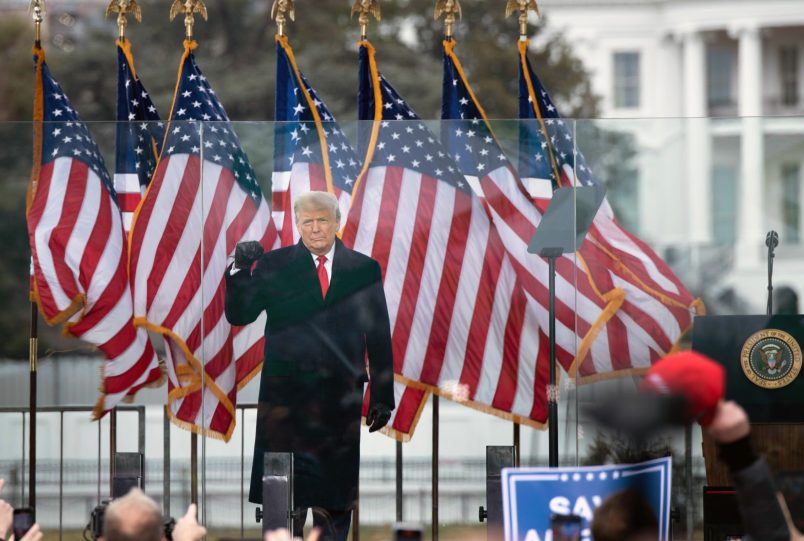Midway through Thursday’s hearing on whether former President Trump can block a subpoena issued by the House Jan. 6 Committee for records from his administration, U.S. District Judge Tanya Chutkan had a question: Why was the panel asking for records going all the way back to April 2020?
“That seems to me to be unbelievably broad,” Chutkan said. “Where is the line drawn?”
Doug Letter, the House general counsel arguing for the committee, did little to help.
Over several meandering exchanges, he told the judge that Trump tweeted about the election in April 2020, but was unable to offer a compelling reason for why it was relevant.
In fact, as Letter well knows and as the judge should know, April 2020 is a key date in Trump’s campaign to subvert the results of the election. It marked the beginning of Trump’s effort to sow doubt about the validity of the election which morphed into the Big Lie that the vote was fraudulent and led in turn to the Jan. 6 Capitol insurrection – the predicate for the Committee’s creation.
But why April 2020?
The conspiracy to subvert the election began in April 2020 for a reason that was obvious then and remains clear now: that was the point at which the month-old COVID pandemic began to impact election administration across the country. Trump first started casting doubt on the election because of COVID-related election measures that made it safer – but also, critically, easier – to vote. Not only did he began to promote the idea that voting by mail was somehow illegitimate, but those around him started to follow suit, setting the stage for the Big Lie that followed his loss and for the insurrection.
COVID
The COVID-19 pandemic delayed spring primary elections in 2020 around the country.
But as the initial shock of the virus’ spread began to wear off, states began to make plans: they would make it easier to vote by mail, allowing voters to cast their ballots without risking infection.
In its earliest days, this proposal was not politicized. Arizona, after all, a red state until the past few years, has allowed voters to request an absentee ballot for any reason since 1991.
But as states moved to expand the opportunities to vote by mail for delayed spring primary elections and for the November general, Trump seized on it. In April 2020, he began to cast the practice as a surefire recipe for fraud, with no evidence, saying that the expansion of vote by mail would result in a “rigged election.”
“The United States cannot have all Mail In Ballots,” Trump wrote in one tweet. “It will be the greatest Rigged Election in history.”
In The Ether
Throughout the month of April and into May, Trump began to wage a war against individual states who were taking measures to increase voting by mail.
Trump’s war set the stage for the chain of events that he used to claim that the election had been stolen: vote counts that dragged on for a week, and a conservative media primed to see pandemic-related voting measures as fostering fraud.
After Michigan’s secretary of state moved to send applications for absentee voting to all voters statewide, Trump threatened to withhold federal funding from the state.
But the specific threats figured into a larger campaign to discredit the practice, one that would prove useful in November 2020 and after.
Under pressure from Trump, the legislatures of three key states that had varying levels of vote by mail refused to enact changes that would have allowed poll workers to process votes before election night. In these states – Pennsylvania, Michigan, and Wisconsin – the counting would go on for days after Election Day, an artificially created delay that Trump would go on to use to cast a cloud on the result.
Fox News went all in on the narrative.
“New report finds string of ballot mishaps confirms fears of large-scale mail-in voting,” read one headline.
The network aired opinions from Republican politicians who responded to Trump’s signal that voting by mail would somehow place the election results in danger of contamination.
“Universal mail-in voting would be disastrous for our country, as there is no way of knowing who is actually voting,” wrote Rep. Greg Steube (R-FL) in an August 2020 op-ed.
Trump’s effort to delegitimize the election was in the ether.
Subversion
By September, Trump had ramped up the campaign, saying that the 2020 results “NEVER BE ACCURATELY DETERMINED” because of vote by mail expansion.
From there, his campaign to delegitimize the vote played out on the foundations that he had built.
“This election is about great voter fraud, fraud that has never been seen like this before,” Trump said after the election, asserting that Democrats had “found” mailed-in votes that stole his victory.
Lawsuits that the campaign and Trump associates filed – all of which failed – cited mail-in voting as a reason for judges to either toss large categories of ballots or to reject state’s electors outright.
It all fed into the Big Lie that the election was stolen.
And on Jan. 6, when Trump spoke to the audience that would go on to the storm the Capitol, he repeated the lie that began in April 2020: “But this year, using the pretext of the China virus and the scam of mail-in ballots, Democrats attempted the most brazen and outrageous election theft and there’s never been anything like this.”
What happened next was the endpoint of the story that, in some ways, began in April 2020.






